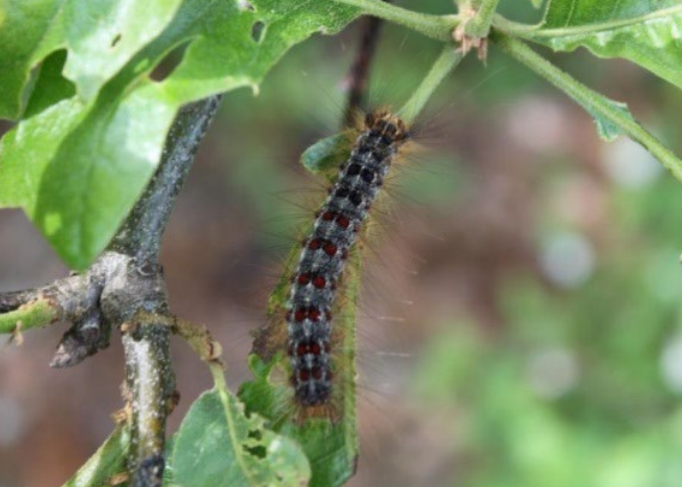
CAES and DEEP Anticipate Heavy Spongy Moth* Defoliation in Litchfield County this Spring
*NOTE: Recent Name Change from Gypsy Moth to Spongy Moth per the Entomological Society of America (explanation & link below)
Connecticut’s Agricultural Experiment Station (CAES) and Department of Energy and Environmental Protection (DEEP) are cautioning residences in northern portions of Litchfield County to anticipate a heavy presence of spongy moth (formerly named gypsy moth) caterpillars this spring along with significant defoliation of hardwood trees. Spongy moth populations rose substantially in 2021 particularly in the Sharon-Cornwall area last year, and spongy moth caterpillars have begun to emerge.
“Our 2021 state-wide gypsy moth egg mass survey, especially in northwestern Connecticut, showed large amounts of spongy moth egg masses, which leads us to believe there will be a continued hatch and extensive caterpillar activity in 2022,” said Dr. Victoria Smith, CAES Deputy State Entomologist. Residents, arborists, and foresters have also reported large amounts of spongy moth egg masses.
“2021 was the first year of widespread defoliation in northwest Connecticut and most healthy trees refoliated in part due to sufficient summer rains. The energy required to refoliate places significant stress on trees increasing the risk of tree mortality in 2022,” said DEEP Director of Forestry Chris Martin.
Wet spring conditions should activate a naturally occurring soil borne fungus, Entomophaga maimaiga, which is lethal to only spongy moth caterpillars and normally keeps their populations in check. Connecticut has experienced similar cyclical outbreaks, most recently in eastern Connecticut that resulted in widespread tree mortality after several dry springs and corresponding consecutive years of defoliation. Wet spring weather eventually returned favoring growth and effectiveness of the Entomophaga maimaiga fungus and ending the infestation.
Annual forest pest and disease aerial surveys conducted by CAES documented spongy moth caterpillars defoliated 156,000 acres in 2020 (mostly in the eastern half of CT) and 45,548 acres in (mostly in Litchfield County) in 2021.
“While most trees will refoliate initially, repeated attacks from spongy moths can weaken a tree’s natural ability to ward off secondary stressors such as drought or other insects and disease. Oaks are most preferred tree species,” continued Martin. “Under heavy infestation spongy moths will eat just about everything with green leaves and even needles. Some people may remember that nearly 1.5 million acres were defoliated by the spongy moth in 1981, and while we lost trees, our forests recovered.”
More information on Name Change Entomological Society of America
'Spongy Moth' Adopted as New Common Name for Lymantria dispar | Entomological Society of America (entsoc.org). The previous name, "gypsy moth," was removed due to its use of a derogatory term for the Romani people. The change is the first undertaken by ESA's Better Common Names Project.
Additional Information and Resources
A comprehensive overview of the spongy moth in Connecticut.
Track the outbreaks of spongy moths in Connecticut.
Learn about the life cycle of the spongy moth and related moths
What you need to know about the spongy moth, including advise on managing their population in your woodlot.
CAES aerial survey map of Connecticut showing areas defoliated by the spongy moth in 2021 (45,548 acres) overlaid with the results of the 2021-2022 CAES egg mass 7-mile grid ground survey.